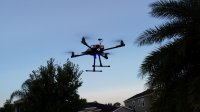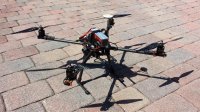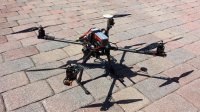So I thought I had built the titanic...well...in MR terms, an un-crashable ship. I studied this and other forums and felt like I had built a fairly meticulous craft. In fact, earlier today, following many, many hours of build time, I launched her on the maiden voyage; no spectators, no cameras. I had faith and hope, among the reservations, that all would go well....and it did! The Tarot 650 quad with Quadrocopter QC 3328 motors, Carbon Fiber 1365 props, AKE 30 amp ESC, Wild Scorpion 4S Lipo 5500 30C and DJI Naza M V2 FC lifted and flew superbly.
It seemed perfectly balanced, held its position and moved nicely between GPS, ATTI and Manual modes. The first flight was 9 minutes and the second (same battery but very low altitude) was around 6 minutes prior to the lipo alarm sounding at 3.4 volts per cell. I later charged the battery. Feeling confident now, I invited the family out to the front driveway to watch. I had previously launched the craft on this fully charged battery for only one minute. I lowered the craft and disconnected the battery. I failed to put a battery monitor on the lipo but knew I would only be in the air a few minutes. Having recorded 15 minutes of flight time on this battery earlier in the day, I was not worried. So...the Tarot 650 launches, GPS mode, all green....hands off the controller and it is steady as a rock for about 1.5 minutes and then all hell breaks loose. The LED flashes RED, the Tarot banks to the left and all I could do from ten feet up is reduce the throttle and let her topple over onto the brick paver driveway. The damaged seems minimal; a scuffed motor shaft and a few scratches on the DJI GPS disk. I recalibrated the GPS only to get the flashing red indication once again.
I trouble shot the system to no avail until I placed the lipo voltage monitor on the battery. Holly cow....2.7 per cell!?! The battery was depleted....but how? Wondering now if I have a short or something? I was meticulous with wiring this thing. Why would a freshly charged battery die so quickly? Anyway....just wanted t share my experience. Obviously I have some work to do. This is unacceptable. I tried so hard to create a craft and environment where this would not happen but still failed by "assuming" that my lipo voltage was alright and by not verifying with a voltage monitor prior to and during that short flight. Live and learn. I have a Tarot 960 essentially built and just waiting a FC and final setup but crashing it WILL NOT be an option. I need to get any kinks out now. A big thanks to Bart and others on this forum that have helped answer questions and provide information through previous posts and communications.
It seemed perfectly balanced, held its position and moved nicely between GPS, ATTI and Manual modes. The first flight was 9 minutes and the second (same battery but very low altitude) was around 6 minutes prior to the lipo alarm sounding at 3.4 volts per cell. I later charged the battery. Feeling confident now, I invited the family out to the front driveway to watch. I had previously launched the craft on this fully charged battery for only one minute. I lowered the craft and disconnected the battery. I failed to put a battery monitor on the lipo but knew I would only be in the air a few minutes. Having recorded 15 minutes of flight time on this battery earlier in the day, I was not worried. So...the Tarot 650 launches, GPS mode, all green....hands off the controller and it is steady as a rock for about 1.5 minutes and then all hell breaks loose. The LED flashes RED, the Tarot banks to the left and all I could do from ten feet up is reduce the throttle and let her topple over onto the brick paver driveway. The damaged seems minimal; a scuffed motor shaft and a few scratches on the DJI GPS disk. I recalibrated the GPS only to get the flashing red indication once again.
I trouble shot the system to no avail until I placed the lipo voltage monitor on the battery. Holly cow....2.7 per cell!?! The battery was depleted....but how? Wondering now if I have a short or something? I was meticulous with wiring this thing. Why would a freshly charged battery die so quickly? Anyway....just wanted t share my experience. Obviously I have some work to do. This is unacceptable. I tried so hard to create a craft and environment where this would not happen but still failed by "assuming" that my lipo voltage was alright and by not verifying with a voltage monitor prior to and during that short flight. Live and learn. I have a Tarot 960 essentially built and just waiting a FC and final setup but crashing it WILL NOT be an option. I need to get any kinks out now. A big thanks to Bart and others on this forum that have helped answer questions and provide information through previous posts and communications.
Attachments
Last edited by a moderator:



